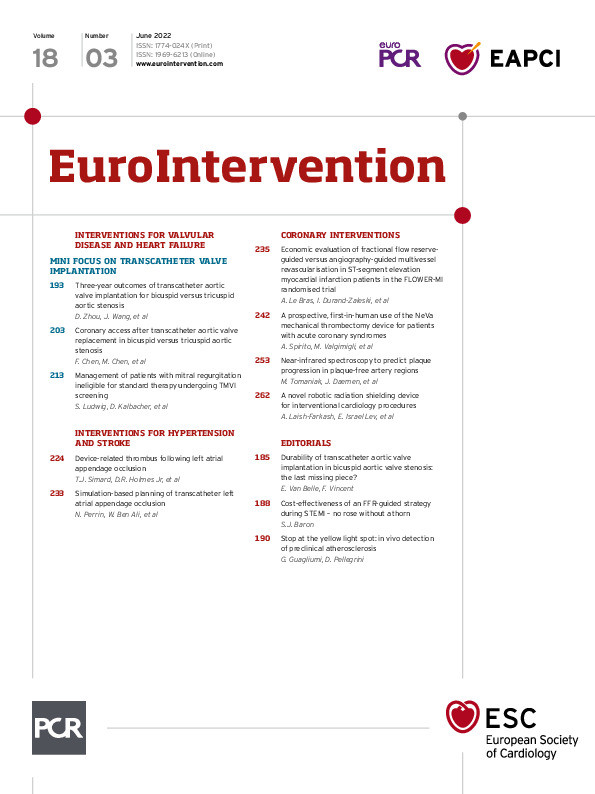Fractional flow reserve (FFR) and other forms of physiological assessment of intermediate coronary artery stenoses have revolutionised how ischaemic heart disease is treated. Economic analyses evaluating the use of FFR to guide percutaneous coronary intervention in stable coronary artery disease (CAD) have demonstrated that FFR is cost effective when compared to an angiography-guided strategy1. Whether these economic benefits extend to a population of patients with multivessel CAD presenting with ST-elevation myocardial infarction (STEMI) has been unknown until now.
In this issue of EuroIntervention, Le Bras and colleagues report the results of a prespecified within-trial economic analysis of the FLOWER-MI trial2. The FLOWER-MI trial randomised 1,171 STEMI patients with multivessel CAD to an FFR-guided vs angiography-alone strategy for complete revascularisation3. Costs were assigned based on trial data regarding resource utilisation during the index hospitalisation and follow-up rehospitalisations. Quality-adjusted life years (QALYs) were calculated using observed changes in health state utilities and observed survival. At 1 year, an FFR-guided strategy was associated with significantly higher costs (mean difference of €471) and lower QALYs (mean difference of −0.011). After non-parametric bootstrapping, angiography alone was projected to dominate FFR 85% of the time with only a 9% chance that FFR would be cost effective at a willingness-to-pay threshold of €100,000/QALY.
When evaluating any cost-effectiveness study, it is important to understand how the analytic perspective and time frame can affect the results. In the economic FLOWER-MI substudy, FFR use was associated with increased costs, both at presentation (due to a longer length of stay) as well as in follow-up (due to higher rates of rehospitalisations). While it could have been hypothesised that an angiography-alone strategy would have incurred higher procedural costs due to greater drug-eluting stent (DES) use, the procedural costs were strikingly similar between the 2 groups. This is likely a direct result of the cost of a DES and an FFR wire being comparable in France, thereby resulting in no substantial cost offset in using a stent-sparing FFR-guided strategy. However, in the United States, an FFR wire is considerably less expensive than a DES, which could have led to a smaller cost difference between the 2 groups or even lower costs in the FFR group. Conversely, in Japan, an FFR wire is more expensive than a DES, which would have resulted in a wider procedural cost difference between the FFR and angiography-guided strategies. Thus, the perspective of the healthcare system from which a cost-effectiveness analysis is performed can have a substantial effect on the calculated costs; this may lead to different conclusions about the economic viability of a specific treatment strategy.
The time frame of an analysis can also substantially affect how cost differences are projected between 2 trial arms. Often, a new technology may be associated with an upfront cost, which is later counterbalanced by a decrease in healthcare resource utilisation and costs in the long term. One of the proffered benefits of an FFR-guided strategy in the FLOWER-MI trial was the use of fewer stents. Since DES implantation has been associated with ~5% risk of in-stent restenosis (ISR) per year4, less opportunity for ISR could result in decreased rates of revascularisation procedures in the future and, thus, lower costs with FFR over time. However, for the effects of this “catch-up” phenomenon (if present) to be realised, the costs and benefits associated with both the FFR and angiography groups would need to be projected for several years, well beyond the 1-year time frame assessed in the FLOWER-MI cost-effectiveness analysis. Thus, whether the cost difference between the 2 treatment strategies could change over time still remains uncertain.
While cost is obviously an important part of any economic evaluation, effectiveness is just as, if not more, important. Hence, whether or not cost estimations may have changed with differences in analytic perspectives or time frames, in the absence of substantial changes in long-term outcomes, it is unlikely that an FFR-guided strategy to treat multivessel CAD during STEMI will ever be cost effective, since it has been shown to be clinically ineffective. While one may posit that studies have yet to suggest that there is any benefit to applying a parsimonious approach to treating non-culprit lesions in the STEMI setting, it is possible that imaging techniques, which allow for the targeting of vulnerable plaques, may prove to be non-inferior, or even clinically superior, to a complete revascularisation strategy based solely on angiographic assessment. If an imaging-guided strategy does emerge in the future, it will be important to thoroughly assess such an approach from all angles since no rose is without a thorn, and, while the advent of FFR has been paradigm-changing in the stable CAD population, the FLOWER-MI trial is the clinical and economic thorn for FFR.
Conflict of interest statement
S.J. Baron received research support from Abiomed, and Boston Scientific; and is a consulting/advisory board member for Biotronik, Medtronic, Shockwave, Boston Scientific, and Abiomed.
Supplementary data
To read the full content of this article, please download the PDF.

